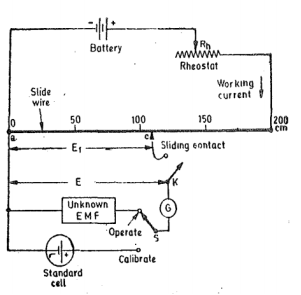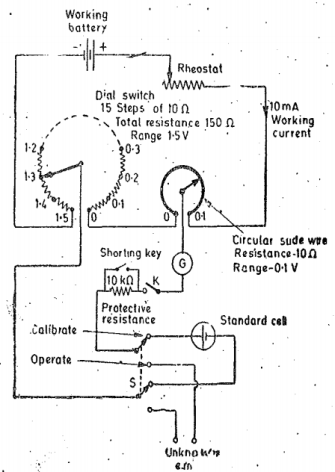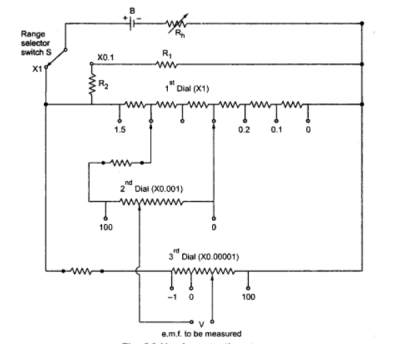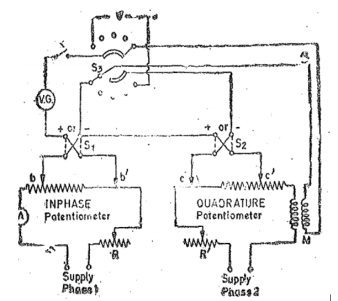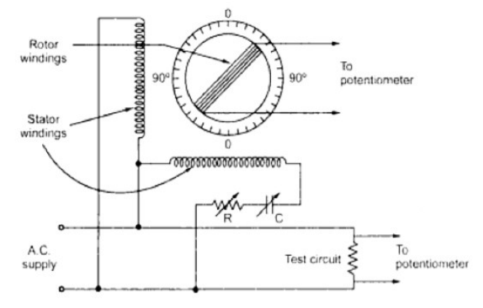Electronics Instruments and Measurement
Unit-5Potentiometer Q1) Explain the principle of potentiometer? A Potentiometer is an instrument designed to measure an unknown voltage by comparing with the known voltage. The known voltage may be supllied by a standard cell or other known voltage -reference source. Measurements using comparsion methods are capacble of high degree of accuracy because the result obtained does not depend on the actual deflection of pointer. Another advantage of potentiometers is that since potentiometer make use of balance or null condition no current flows and hence no power is consumed in the circuit containing the unknown emf when the instrument is balanced. Potentiometers are extensively used for calibration of voltmeterrs and ammeters. Q2) Explain the standardization of potentiometer?
Figure 1. Basic slide wire PotentiometerThe procedure for standardisation of the potentiometer is as shown in figure. The slide wire has total length of 200cm and resistance of 200Ω. The emf of the standard cell is 1.0816 V . Switch ‘S’ is thrown to ‘calibrate’ position and the sliding contact is placed at 101.86cm mark on the slide wire scale. The rheostat R is now adjusted so as to vary the working current. This adjustment is carried on till the galvanomter shows no deflection when key ‘K’ is pressed. Under these conditions the voltage drop along the 101.86cm portion of slide wire is equal to stanadard cell voltage of 101.86V . Since 101.86cm portion of slide wire has a resistance of 101.86Ω the working current in fact has been adjusted to value :1.0816/101.86 x1000 = 10mA The voltage at any point along the slide wire is proportional to the length of slide wire. This voltage is obtined by converting the calibrated length into corresponding voltage simply by placing the decimal point in the proper position eg 153.6 cm = 1.536 V . If the potentiometer has been calibrated once its working current is never changed. Q3) What are the applications of potentiometer?In addition to measurement of voltage the potentiometer is the usual basis for calibration of all voltmeters, ammeters and wattmeters. The potentiometer may also be used for measurement of current, power and resistance. Since the potentiometer is a dc device the instruments to be calibrated must be d.c or electrodynamometer types. Q4) Explain Crompton Potentiometer? The slide wire type potentiometer is not a practical form of construction. The long slide wire is awkard and even for the length shown cannot be read to a very great degree of precision. Modern laboratory type potentiometers use calibrated dial resistors and small circular wire of one or more turns therby reducing the size of the instrument . The circuit is shown in the figure. There is one dial switch with fifteen steps each having precision resistor . There is also single turn circular slide wire . For the case shown the resistance of slide wire 10 Ω each. Thus dial has total resistance of 150Ω and in addiiton the slide wire has a resistance of 10Ω. The working current of the potentiometer is 10mA and therefore each step of dial switch corresponds to 0.1V. The slide aire is provided with 200 scale divisions and since the total resistance of slide wire corresponds to a voltage drop of 0.1V each division of slide wire corresponds to 0.1/200 = 0.0005V. This potentiometer is provided with double throw switch which allows the connection of either the standar cell or unknown emf to be applied to the working circuit. A key and protective resistance is used in the galvanometer circuit. In order to operate the galvanomter at its maximum sensitivity provision is made to short the protective resistane when near the balance conditions.
Figure 2. Crompton’s Potentiometer Q5) Explain Vernier Potentiometer? The main difference in simple and vernier potentiometer is that it uses three measuring dials. The slide wire is not used in this type of potentiometer. The main dial that is the first dial measures upto 15V range in steps of 0.1 volts. The second dial reads upto 0.1V in steps of 0.001 volts on the range. It consists of 102 studs. The third dial again with 102 studs measures from 0.00001 to 0.001 volts on range. This third dial provides true zero and negative setting. The function of range selector switch S has range resistance R1 and R2. The resistances of the second dial shunt two of the coils of the main dial. The moving arm of the second dial carries two contacts which are placed two studs away from each other. The vernier potentiometer reads voltages of 10μV on X1 range while 1μV on X0.1 range. To have voltage reading of 0.1μV one more range X0.01 may be provided.
Figure 3. Vernier PotentiometerSometimes thermal sheilds are alo used to enhane process of reduction of potentials. Q6) Explain co-ordinate potentiometer? The potentiometer consists of two separate potentiometer . One is called in-phase and the other quadrature. The slide wire circuits are supplied with currents which have phase difference of 90 o . The figure shows the connections of the potentiometer . The in-phase and quadrature potentiometer circuit are as shown in figure. bb’ and cc’ and rheostts R and R’ are for current adjustments. The supplies to the potentiometer are obtained from single phase supply by means of arrangement as shown in figure.
Figure 4. Gall type PotentiometerThe current in the in-phase potentiometer wire is first adjusted to its standard value by means of direct current supply and standard cell. The vibration galvanometer is replaced by galvanometer of the d’Arsonval type for this purpose. The dynamometer ammeter is of the torsion head type and the torsion head is turned to give zero deflection on direct current. This setting is left untouched during calibration with alternating current the slide wire current being adjusted to give zero deflection again. The vibration is then placed in circuit and direct current is replaced by alternating supplies. The magnitude of the current in the quadrature potentimeter wire must be the same as that in the in-phase potentiometer. These two currents must be exactly in quadrature. Rheostat R is adjusted until the current in the in-phase potentiometer wire is the standard value. The selector S3 is then switched on to test position . The emf induced in the secondary winding of the mutual inductor M assuming M to be free from eddy currents effects will lag 90 o in phase behind the current in the primary winding. If I is the primary current then emf induced in the secondary is 2π x frequency x M xi, where M is value of mutual inductance. Q7) Explain polar type potentiometer? It is basic d.c potentimeters along with some auxillary components such as drysdale phase shifter and electrodynamometer type ammeter. When current flows through stator winding a rotating field is produced inducing emf in the rotor.The phase of rotor current can be changed through any angle relative to stator supply voltage by rotating rotor.Thus the change in the phase of secondary emf is equal to the angle through which rotor is moved from its original position.
Figure 5. Polar Type Potentimeter Q8) During the measurement of low resistance using Potentiometer the following readings were obtained Voltage drop across the low resistance under test =0.4221V Voltage drop across a 0.1 Ω standard resistance = 1.0235 V Calculate the value of unknown resistance current and power lost in it. Solution:
Q9) What are the advantages of potentiometer? 1) Potentiometer works on zero deflection method so possibility of error is small. 2) The standardisation of potentiometer can be done directly with standard cell.3) Highly sensitive so can be used to measure small emfs 4) For accuracy the length of potentiometer wire can be increased according to requirement.5) It does not draw any current from the circuit which is used for measurement. Q10) What are the applications of potentiometer? The potentiometer is used as a voltage divider in the electronic circuit. The potentiometer is used in radio and television (TV) receiver for volume control, tone control and linearity control. The potentiometer is used in medical equipment. It is used in wood processing machine. It is used in injection mould machines.
|
|
|
|
|
Resistance of the unknown resistor R = VR/VS = 0.4221/1.0235 x 0.1 = 0.041218Ω. Current through the resistor = VB/S = 1.0235/0.1 = 10.235 A Power loss in unknown resistance = I 2 R = (10.235) 2 x 0.041218 = 4.13 W |
0 matching results found
